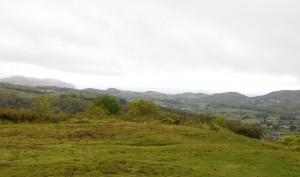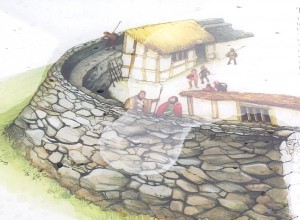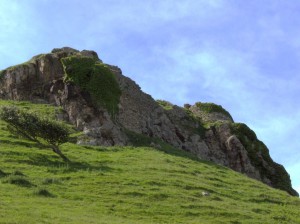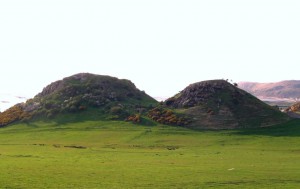The Song-Sayer’s Lament is my fifth novel, this one set in Sixth Century Britain and, since it’s always my habit to check out the locations I’ve used as settings, I recently began to walk some of the wild ground over which the story takes place. And, since that story starts in the ancient kingdom of Rhos, I began my journeys at the North Wales coastal town of Rhos-on-Sea. The Song-Sayer’s Lament is written in modern English, so I had been keen to avoid the trap of filling the book with “Welsh” names, which might not signify to English-speakers the original meanings. And Rhos is a good example. The word rhos is now generally translated as meaning moorland or similar. But that didn’t fit the nature of the area, until one of my sources helpfully told me that it can also mean headland – which fits perfectly, since this part of the North Wales coast, the ancient kingdom of Rhos, is known for its promontories and, most, notably, the Little Orme and Great Orme. So the area appears in the novel as Headlands. And one of the first locations to which we’re introduced is the hill fort, or holdfast, that I called Bear Fort. In practice, this is the hill fort that sits on top of the Bryn Euryn Nature Reserve in Rhos-on-Sea. From Junction 20 on the A55, you follow the B5115 (Llandudno Road) until coming to a set of traffic lights, with a sign to the Nature Reserve. This takes you up Rhos Road and across to the Reserve itself, just opposite. There’s a car park just up on the right of the Reserve road, from which you simply retrace your steps a few yards until you see the footpath signs – a Red Route and a Green Route. Steps take you up to the ruins of an old manor house, Llyn Euryn,

with links to the Thirteenth Century’s Ednyfed Fychan, a descendant of the area’s old tribal rulers. Soon after Llyn Euryn, the path divides, with the Green Route taking you to the hill fort of Dinerth – old Welsh Din Eirth, meaning the Bear’s Fort. The climb up to the summit is worthwhile since, from the top, you can survey most of the territory that once constituted the Kingdom of Rhos (or Headland) – extending from the Great Orme and Creuddyn Peninsula and down the Vale of Clwyd. There’s a decent information board showing the way Dinerth would once have enjoyed a solid limestone outer rampart, and there are fine views (in good weather) southeast to the Snowdon range, west to the Clwyd Estuary and Anglesey, north up the Irish Sea, and east to the Point of Ayr. Interesting details

too from the time when, in the Second World War, the hill fort was used as a Home Guard Observation Post. So easy for me to picture my main protagonist, Ambros Skyhound, born here and standing upon the ramparts, bathing in the beauty of the place and dreaming of ways in which he might make his Bough-Gatherer (Deceangli) Folk the most powerful in post-Roman Britain. And when I’d finished doing that? I headed down to the Rhos-on-Sea promenade for a very pleasant lunch at the La Reina tea shop!
In the afternoon, I carried on to Deganwy, taking the A546 from Llandudno Junction. Just after the

Deganwy Quay Marina, turn right into All Saints Avenue and head to All Saints Church – where there’s parking. The destination’s clear. The twin hills of the Vardre stand behind the church, with the ruins of Deganwy Castle clearly visible. The Welsh name for this site is Castell y Faerdre – the Castle of the Maedref (Settlement), and the word Vardre comes from that same source. Yet we seem to have no clue what the site may have been called when, in the Sixth Century, this was supposedly the stronghold of Maelgwyn Gwynedd. There is archaeological evidence of occupation in that period, and Roman coins have been found there too – which may mean Roman occupation, or simply occupation by Romano-Britons utilizing Roman coins. The Anglo-Saxon Chronicles tell us that the lightning was struck by lightning in 812 AD and that, soon afterwards, it was destroyed by Saxon raiders. Later, Robert of Rhuddlan had his seat here in the Eleventh Century. After his death in battle against the Welsh, Llywelyn ap Iorwerth rebuilt the site around 1213. But today’s ruins date from the building work of Henry III, thirty years later. It was eventually destroyed in 1263 AD by Llywelyn ap Gruffudd.

But back to the Sixth Century. I was keen to feature this location, not as Maelgwyn’s base, but as the holdfast of Ambros Skyhound’s father, Owen White-Tooth. And I gave it the obvious name, Twin Sisters. So today I headed up the footpath, to the stile and information board which shows what the castle would have looked like under Henry III. The Sixth Century hill fort would have looked different, of course, presumably constructed like that of Dinerth – limestone ramparts and wooden palisades, with a gather-hall – but almost certainly still occupying both summits. Unfortunately, my camera battery failed at this point so I’ve had to “borrow” a few photos from the www.castleswales.com site. But the path took me up through the remains of the old gateway and bailey, then away to the left, and the ruins of the later hall. Above here, there were some fine views from the western peak. North over Llandudno and the Great Orme. South over the Conwy Estuary, to the majestic ruin of Conwy Castle, and across to Snowdonia. West to Puffin’s Island and Anglesey. Beautiful! The remains of the old curtain wall were there too, and I followed those down again, into the dip, so I could climb the eastern peak. And there, the scent of wood smoke hit me from somewhere below, made me start, because it was here that Ambros was forced to light the funeral pyres for his father’s settlement after the Yellow Pestilence (the Plague of Justinian) had hit them!
Returning to the car park, I strolled further along the A546 (Station Road) to the Tea Station. Great selection of food, friendly staff – but even better homemade cakes. To be fair, Deganwy’s got more than its fair share of decent eating places but I like the Tea Station. In Part Two, I’ll visit some of the hill forts deeper into Snowdonia, but all featured in The Song-Sayer’s Lament (published in May 2015).
Leave a Reply